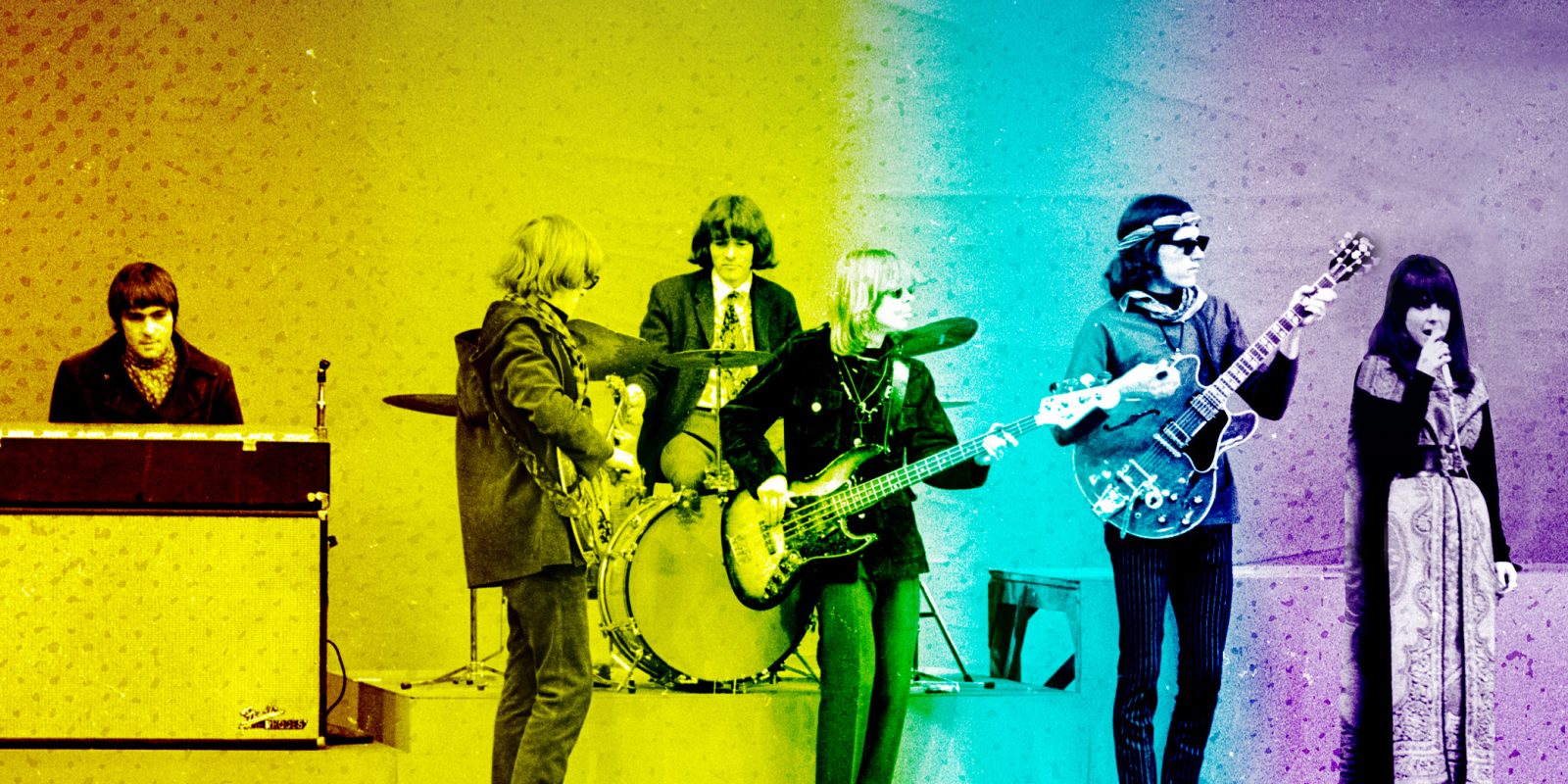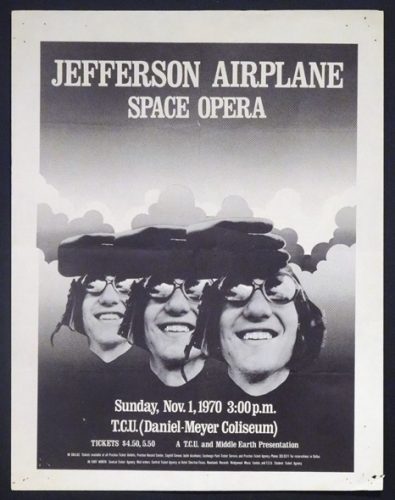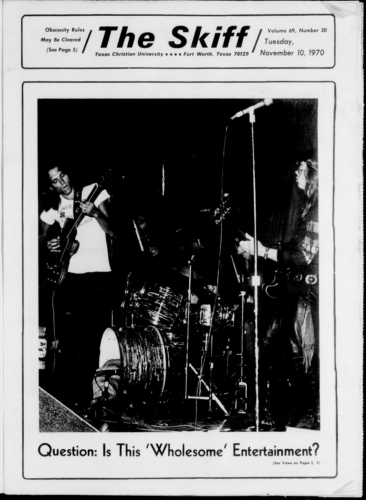
Michael Ochs Archives | Getty Images
Jefferson Airplane Concert Pushed the 1970 Limits of TCU
The band rocked on campus and caused a stir. But maybe that was the point.
Got a revolution. Got to revolution. One generation got old. One generation got soul.
Jefferson Airplane, with hits including “Volunteers,” “Somebody to Love” and “White Rabbit,” played alongside The Who, Jimi Hendrix, the Grateful Dead and Janis Joplin at 1969’s Woodstock festival.
A key player in the psychedelic rock music movement of the 1960s and ’70s, Jefferson Airplane was a leading voice in the counterculture zeitgeist.
Meanwhile, hippie vibes had wafted over to TCU. Sideburns and miniskirts speckled campus, and student activists were gaining a voice. They started questioning the in loco parentis stance of the university’s administration, meaning they challenged the idea that TCU should assume a parental role and determine proper student decorum.
Dee Simpson ’71 (MS ’74), a self-proclaimed provocateur, made it his mission to bring influential performers to campus. He was chair of the entertainment committee that landed the on-campus Jefferson Airplane concert in 1970.
Simpson, then a senior history and political science major, didn’t elaborate on the band’s political leanings with the administration. “I imagine I was careful with how much I revealed,” he said.
The band’s 1969 Volunteers album “was pretty out there,” said Simpson, a lobbyist who recently worked in his 22nd session with the Texas Legislature. With anti-war lyrics and ample profanity, the LP went gold. “They were essentially, in their way, writing anthems for armed revolution,” he said.

Posters advertised the concert, helping to draw a crowd of more than 6,500. Dee Simpson, the entertainment committee chair, kept low-key about the rock group in dealings with the administration. Courtesy of Dee Simpson
Though the university did an excellent job with formal cultural events such as dance and theatre performances, Simpson said, TCU “didn’t know what to do with the emerging youth culture issues.”
Simpson said he wanted to shake things up.
A Fort Worth-based music promotion group, Middle Earth, had won the bid to host a Jefferson Airplane concert. The company just needed a venue. Will Rogers Auditorium and the Tarrant County Convention Center were off the table, leaving TCU’s Daniel-Meyer Coliseum as the only available venue with the size and acoustics to satisfy the Airplane.
Middle Earth forged a deal with TCU and Simpson.
On Sunday, Nov. 1, 1970, Space Opera warmed up the crowd of 6,500-plus, which included about 1,000 students, according to The Skiff. Simpson said he remembers more students in attendance than the number reported by the student newspaper.
Simpson and the entertainment committee hired a dozen students, including Harry Paul Ally ’72, then a junior painting major, to help manage crowd control.
“I remember people throwing candy at us,” Ally said, recalling a playful mood. “Then the Airplane came on stage and it didn’t matter — everyone just rushed up to the front of the stage. There was nothing we could do.”
At one point during the show, Simpson said, a Dallas-Fort Worth radio disc jockey took the stage and announced that police were not at the concert. He pointed to the silver and purple TCU-branded ashtrays.
“You can smoke your joints, but leave some for the maintenance staff,” Simpson recalled him saying.
For more than three hours the audience rocked with Jefferson Airplane and Hot Tuna, the band’s side project that gave pregnant vocalist Grace Slick a break. Shifting psychedelic scenes were projected onto the basketball arena’s walls.
“I remember it being fun and peaceful,” said Ally, now an artist in San Miguel de Allende, Mexico.
But by the end of the week, buzz around campus grew, and Simpson had resigned from the student chair position. Rumor was marijuana smokers and underage drinkers (all alleged to be non-TCU students) quashed the possibility of future university-sponsored rock concerts.
The Nov. 10 issue of The Skiff featured a picture of Jefferson Airplane guitarist Paul Kantner, swastika around his neck, and bassist Jack Casady above the headline “Question: Is This ‘Wholesome’ Entertainment?”
Shirley Farrell ’71, the student paper’s editor in chief, detailed the concert complaints. “The very enthusiasm begged for in the past may bring a veritable shutdown of certain shows,” she wrote.

The Nov. 10, 1970, cover of The Skiff featured a nearly full-page image of Jefferson Airplane and the deadline “Question: Is This ‘Wholesome’ Entertainment?” Courtesy of TCU Special Collections
On the same page as the article: a National Bible Week advertisement featuring Sonny and Cher and the words, “Look who reads the Bible.”
TCU athletic director Abe Martin ’32 (MEd ’45) told The Skiff he worried about Daniel-Meyer Coliseum, where the Horned Frogs played basketball. He noted chewing gum, beer cans and liquor bottles left behind by concertgoers.
Numerous students, including Ally, wrote letters to the editor expressing their views and definitions of “wholesome.”
“It is also my conviction that for a university to provide its students with a sound, well-rounded education, social functions such as rock concerts are an essential facet of education,” Ally wrote.
Administrators indeed restricted entertainment funds, but TCU students wanted more rock. A year after the Airplane show, the Grateful Dead played at Daniel-Meyer. The only hiccup in the latter event was a minor change in the start time so the first-semester women could be home by midnight curfew.
Simpson said the Jefferson Airplane concert served its purpose. “Yes, we were trying to have some fun. Yes, we made a couple mistakes — we didn’t know what the hell we were doing,” he said. “But it was a good thing. Those kids got to hear some good music, and they got to see a different world through music.”

Your comments are welcome
4 Comments
Nice rock blast from the past–thanks. But it’s Jorma Kaukonen on guitar in the photo with Jack Casady, not Paul Kantner.
The picture above from the Nov. 10, 1970 cover of The Skiff is not Paul Kantner and Jack Cassidy but rather of Jorma Kaukonen, lead guitar player, and Jack Cassidy. Paul Kantner typically played rhythm guitar. The “swastika” looks to be something printed on his t-shirt rather than “around his neck”.
I attended this show as a 13 year old 8th grader from Arlington. Local boys Space Opera were just flat mesmerizing. Grace Slick sang just a few songs because she was 7 months pregnant. Jorma, Jack, and Papa John were able to show off their talent with extended jams because of that.
That’s a Hindu swastika around Jorma’s neck. He also wore it at Woodstock. He has clarified that it represented Hinduism, not Nazism, but still apologized for it.
Related reading:
Mem’ries Sweet
KTCU Host Interviewed Celebrities like Bob Hope, Don Knotts
Barto Farrar brought bandleaders, country stars and even a Nobel-winning scientist to the KTCU airwaves.
Features
Dead on
Hippies and debutantes danced side by side with ROTC cadets and trust fund kids at the 1971 Grateful Dead show at TCU.
Features
1971: The Times, They Were A-Changin’
As a divisive war in Vietnam wound down, a tech revolution and a new academic era at TCU were dawning in 1971.